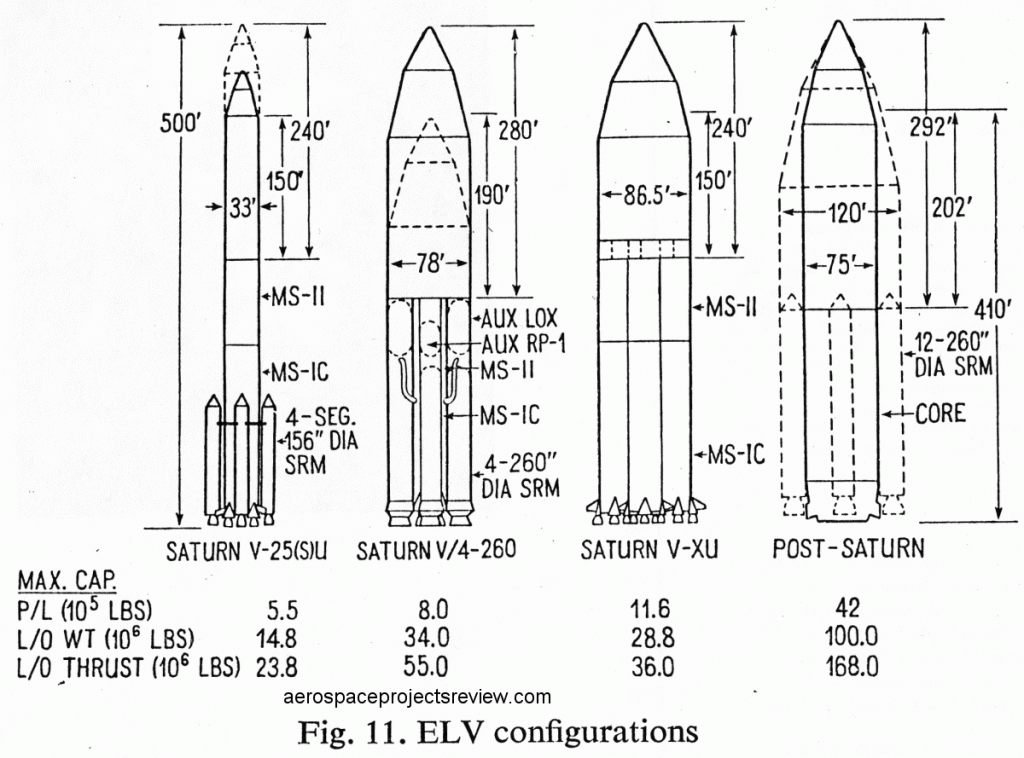In 1968, Boeing (manufacturer of the S-IC stage of the Saturn V) put out an illustration of advanced derivatives of the Saturn V. Published in the XIXth International Astronautical Congress, these included the Saturn V-25(S)U, which was a stretched Saturn V with improved F-1 and J-2 engines, with four 156″ diameter solid rocket boosters; the Saturn V/4-260, which used the same improved Saturn V, but with four 260″ diameter solid rocket boosters, with additional first stage liquid propellant in tankage ahead of the solid boosters. Additionally, the payload shroud could be increased in diameter from ten meters to 78 feet,and up to 290 feet in length. Further included was the Saturn V-XU, which was four improved Saturn V’s clustered together (both first and second stages), with a payload shroud 86.5 feet in diameter and 240 feet long; and an all-new Post-Saturn concept with a 75-foot-diameter core vehicle with optional 260″ diameter solid rocket boosters (up to twelve) and a payload shroud up to 120 feet in diameter. A payload of up to 4.2 million pounds was envisioned.
Two length options were shown… 410 feet and 500 feet. The 410 foot-long vehicles could be assembled within the VAB; the 500 foot-long vehicles would require that the payload be stacked onto the vehicle outside the VAB using a new crane mounted to the VAB roof.

There were a few other interesting variations in that era, including an MLV with four 230-inch hypergolic pods and F-1A-powered boosters a la FLO Comet/Dynetics Pyrios (but bigger). There’s a good walk-through of Saturn alternatives in the Boeing IMISCD study, which itself is a fascinating read if you’re a Class 1 nerd and really want to get into the trade studies.
The “Post-Saturn” in the IMISCD study is very similar to the AMLLV, as the studies were conducted in parallel. The AMLLV study is also a great read in terms of trades, including 330-inch and 372-inch solids and big hypergolic pods (which actually gave the highest payload). In the end they went with the “conventional” 260-inch solids and a slightly smaller core than this Post-Saturn effort.
That’s enormous! It would almost be more efficient to throw the payload off the roof of the VAB and point the rocket at the ground to push the earth further away!
And a quick back-of-an-envelope calculation, any of those could quite easily lift an entire house into LEO.
I’ve always wondered if the plan was to build a new, more massive crawler to take the whole V-XU stack in one trip to the launch complex. If so, how were they planning to reinforce the crawlerway (that task is expected to be problematic for even the weight of today’s combined MLP/proposed Block II SLS designs, which would certainly be a quarter of the weight of the V-XU)? Perhaps they were planning to transport the individual V-XU cores in 4 trips, and clustering them at the launch pad.
And imagine the scale of the totally-new launch complex they would have to build to launch the thing! At minimum, they would have to build it in the middle of a lagoon; hopefully the water would be shaped into a parabolic shape by the shock wave of the launch, thus sparing the surrounding area from the blast. (It would also be essential to engineer the lagoon in such a way that the shock wave would not impinge on the launch vehicle in any focused way, of course).
It probably would have been far more practical to stick with the proposed Saturn MLV-V-1. NASA would have to “resign” itself to launching 137,250 kg payloads into orbit (or more, if J-2S motors were used on stages II and III), and assembling those into space stations, interplanetary spacecraft, modules for lunar or Mars bases, etc. Poor NASA! (Yes, I am being ironic).
-Stu Young
Fear the mutated Saturn V. FEAR it.
This feels like its going KSP. Just add more boosters!